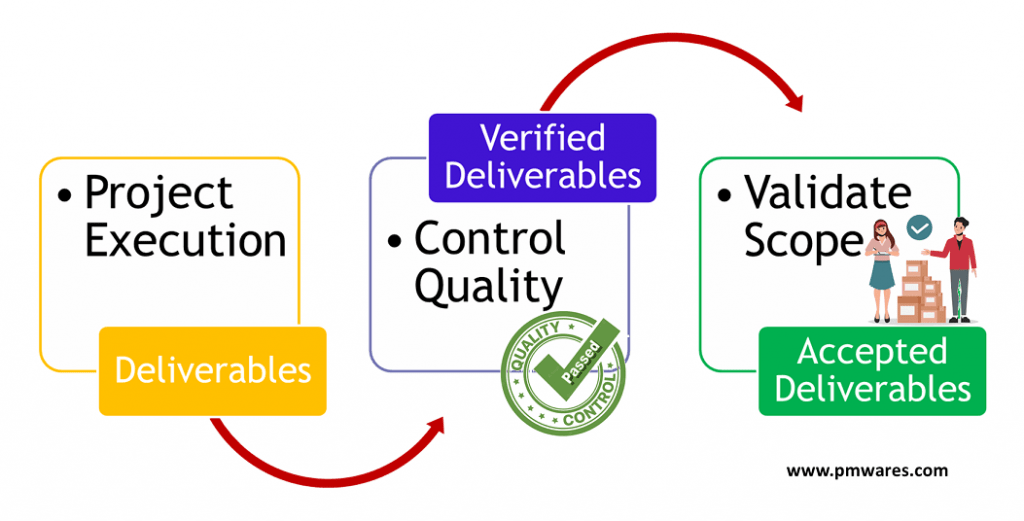Validate Scope vs Quality Control

Understanding the Differences between scope validation & quality control and Importance in Project Management
Introduction:
Continuing with my previous post – Validate Scope Vs Control Scope, I am here again with another set of terms Validate Scope vs Quality Control that often confuse people. Understanding difference between these terms will not only help Project Management Professional to implement them better in the projects but also help PMP Certification aspirants to answer the questions on PMP Exam correctly.
In project management, ensuring that deliverables meet the required standards and specifications is crucial for successful project execution. Two key processes involved in this regard are “Validate Scope” and “Quality Control.” While they both focus on evaluating project outputs, they serve distinct purposes and play vital roles in maintaining project quality. This post aims to explore the differences and importance of Validate Scope and Quality Control in project management.
Quality Control:
Quality Control in Validate Scope vs Quality Control, focuses on monitoring and verifying that the project outputs meet the required quality standards and specified requirements. Control Quality checks a deliverable for conformance to the requirements. That means it checks for the correctness of the deliverables against requirement specifications. The key activities involved in Control Quality include:
Inspection and Testing:
Quality Control involves conducting inspections and tests to assess the deliverables’ quality against the requirements specifications. It ensures that the deliverables conform to the requirements. Quality control is responsible to pass the deliverables or fail them if there are defects or deviations from requirements. Key role is tester who performs the testing and inspection. In quality control process, stakeholders are generally not involved.
Compliance and Standards:
Quality Control ensures that the project outputs meet the necessary regulatory and industry-specific requirements. It helps organizations maintain compliance with relevant standards and regulations.
Corrective Measures:
Any deliverables that do not meet the requirements or comply with standards is rejected and sent for corrective action. The deliverables are rectified or repaired to pass the quality test. The deliverables may not be repairable and may be rejected.
Managing Change Requests:
Change request are not so common in Quality Control as stakeholders are not involved but it cannot be ruled out. Team may identify some missing requirement and raise a change request. Stakeholders often raise change requests with respect to quality also during scope validation.
Validate Scope:
Validate Scope in Validate Scope vs Quality Control, is performed when a deliverable is ready to be delivered. Its primary objective is to ensure that the deliverables produced is complete in all respect and meet expectations defined in the project scope statement. The key activities involved in Validate Scope include:
Inspecting Deliverables:
Validate scope is primarily be done by a team member who was responsible for understanding and documenting the customer requirements. Often called Business Analyst. BA, along with key stakeholders, reviews the completed deliverables to verify if they meet the specified acceptance criteria.
Acceptance Criteria:
The process utilizes predetermined acceptance criteria, which are established during requirements gathering and signing off the scope. These criteria act as benchmarks for determining whether the deliverables meet the required specifications.
Obtaining Acceptance:
The business analyst seeks formal acceptance from the stakeholders for the completed deliverables. This process involves obtaining sign-offs and document confirmation.
Corrective Measures:
Any deliverables that are not accepted are sent back for corrections. It may be quality defect or not complete to be acceptable. The deliverables are rectified, repaired or completed to meet the acceptance criteria and be accepted.
Managing Change Requests:
During the scope validation, stakeholder may suggest new changes. Any requested changes or modifications to the deliverables are documented and processed through the integrated change control system.
The importance of Validate Scope lies in ensuring that the project deliverables complete in all respect. In other words, they are aligned with stakeholder expectations. It helps prevent scope creep and ensures that the project remains on track.
Differences between Validate Scope and Quality Control:
Timing:
Quality control generally performed before Validate Scope. When a deliverable is produced, it first goes through quality control for correctness. Passing from the quality control it is called verified deliverable. Then verified deliverable goes through validate scope for completeness. BA while performing validate scope involves other stakeholders and ensures that correct and complete deliverables are accepted.
Objective:
Quality Control focuses on correctness while Validate Scope focuses on completeness.
Activities:
Validate Scope involves inspecting deliverables, obtaining acceptance, and managing change requests. Control Quality involves testing the deliverables against requirements and identify defects or deviations from specifications.
Conclusion:
In summary, while Validate Scope and Quality Control share the common goal of evaluating project outputs, they operate at different stages and cater to distinct aspects of project management. Validate Scope focuses on ensuring that the deliverables align with the approved project scope and stakeholders’ expectations, while Quality Control emphasizes the overall quality by identifying defects and deviations from specifications.
Both processes are vital for project success, contributing to customer satisfaction, risk mitigation, and adherence to quality standards. By effectively implementing Validate Scope and Quality Control, project managers can enhance project performance and deliver successful outcomes.
How have you managed these processes in your projects? I am keen to learn your experience. Please share your thoughts and experience in the comment section.